A Detailed Comparison Between WordPress And October CMS
Three months ago, WordPress finally released React-powered Gutenberg to power its default content editing experience, triggering many people who are not happy with this change to look for alternatives. Some folks decided to fork and release pre-Gutenberg WordPress, however, for me this doesn’t make much sense since it still carries 15 years worth of technical debt. If I were to find an alternative to WordPress, I would try to avoid being stuck in the past, and aim for a clean cut through some mature platform built on modern foundations.
This article compares WordPress to the arguably similar yet more modern October CMS on a wide arrange of both technical and non-technical topics. The goal of the article is not to convince people to stick to WordPress or to switch to October CMS, but simply to demonstrate what aspects must be taken into account before concluding the move to a different platform. The same comparison could (and should) also be done with other platforms before making a sensible decision.
Why October CMS
I found out about October CMS when it won an award, after which I went into research mode and spent a good deal of time digging deep into this CMS — from the perspective of both a user and a developer. As I gained knowledge on this CMS, I felt confident that I could provide an objective evaluation of its features as contrasted to WordPress. I chose this CMS for the comparison over alternative options such as Grav, Statamic, ButterCMS, Joomla, Drupal, Jekyll, Hugo, and others, for the following reasons:
- I know how this CMS works (unlike Grav);
- It is free and open source (unlike Statamic and ButterCMS);
- At five years, it is “relatively” new (unlike Joomla and Drupal);
- It is a dynamic (not static) content generator and based in PHP (unlike Jekyll and Hugo).
I believe that October CMS is a good candidate because it is based on Laravel which is a framework used for building modern applications. After seven years of existence, it has received positive approval from developers (as evidenced by its sizeable community and ecosystem), and marks a distinct contrast over coding in WordPress, i.e. WordPress is mostly procedural programming while Laravel is decidedly object-oriented programming.
What’s The Difference Between The Two?
Below I will compare WordPress and October CMS on different categories and highlight what, I believe, is good and not so good about them. However, I will not pick a winner, since that’s not the objective of the article and, in any case, there is no “best” or even “better” CMS: each CMS has its own set of strengths and weaknesses that will make it more or less suitable for each task, project, company, team, and anything else. Moreover, a project may benefit from using more than one CMS, such as using some CMS to manage and provide data, and another CMS to render the view. To decide which of the dozens of CMSs out there is most suitable for your own needs is entirely up to you.
In addition, this article could never draw definitive conclusions since it is only concerned with a subset of all possibilities. For instance, we can also find online comparisons such as “WordPress vs Drupal vs Joomla”, “WordPress vs Static Site Generators” and even “WordPress vs Medium”. Because none of these articles sees the full picture, then none of these comparisons can ever be conclusive, and should not be treated as such.
Let’s start with the comparison.
Philosophy And Target Group
It is no coincidence that WordPress powers nearly 1 in 3 websites. Ever since its inception, it has strived to be extremely user-friendly and has done so successfully, removing friction for technical and non-technical users alike as well as for people from all backgrounds — irrespective of their education and economic levels. WordPress’ founder Matt Mullenweg expressed that WordPress’ motto of “Democratize Publishing” for the current era meant the following:
“People of all backgrounds, interests, and abilities should be able to access Free-as-in-speech software that empowers them to express themselves on the open web and to own their content.”
WordPress is easy to use for everyone and its inclusivity is evidenced on the development side too: It’s not uncommon to find people without a programming background (such as marketers, designers, bloggers, sales people, and others) tinkering with their WordPress installations, designing their own themes and successfully launching their own websites. WordPress is user-centric, and the needs of the users trump those of the developers. In WordPress, the user is king (or queen).
In contrast, October CMS is more geared towards the developer, as explicity established from its very first release:
“October makes one bold but obvious assumption: clients don’t build websites, developers do. The role of a client is to manage the website and convey their business requirements. The web developer, and the industry itself, revolves around mediating these factors.”
In the words of its founders, the CMS’ mission is to “prove that making websites is not rocket science.” Being based on Laravel, October CMS can claim to have strong foundations of reusable, modular code that can produce properly-architected applications, maintainable in the long term and fully customizable without requiring hacks — the type which attracts serious programmers. October CMS can also provide a great user experience, however, it is not as simple or frictionless as that provided by WordPress. Users may need to be explained how to use certain functionality before being able to use it. For instance, embedding a form from some plugin has a lengthy explanation on how to do it, which is more cumbersome than the self-evident, drag-and-drop functionality provided by several form plugins in WordPress.
Installation
WordPress is famous for its 5-minute installation, even though many people point out that (taking into consideration all the plugins that must be installed) a typical installation requires 15 minutes or more. In addition, WordPress also offers the Multisite feature, which allows us to create a network of multiple virtual sites under a single installation. This feature makes it easy for an agency to administer the sites of multiple clients — among other user cases.
Installing October CMS is also very smooth: The Wizard installation itself takes even less than five minutes, and if you install it through the Console installation, it is even faster. You can do the latter by simply navigating to the target directory and then executing curl -s https://octobercms.com/api/installer | php (after which we need to input the database configuration, otherwise it behaves as a flat-file CMS). Once the installation has been completed, we will have a fully functioning website, but still quite bare (if you add the time needed to install and configure the required plugins, you can expect it to take at least 15 minutes).
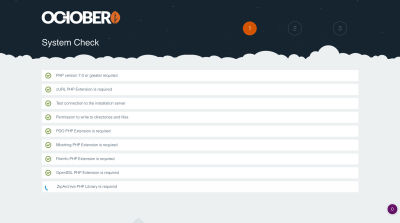
Security
WordPress has been accused of being insecure due to the high amount of vulnerabilities that are constantly found. This forces users to have the software for the CMS and all installed plugins always up to date to avoid security exploits. Among the main issues is WordPress’ support for older versions of PHP which are not supported by the PHP development community anymore (WordPress currently supports PHP 5.2.4, while the latest fully supported PHP version is 5.6). However, this problem should be resolved in April 2019 when WordPress will officially start supporting PHP versions 5.6 and upwards.
Otherwise, WordPress is not necessarily insecure because of itself, but because of its high popularity, which makes it a primal target for hackers. However, this plays both ways: WordPress ubiquity means that its security team must really take their job seriously by constantly looking for exploits and fixing them as soon as possible, otherwise up to a third of the web is at risk. The stakes are just too high.
October CMS, on the other hand, doesn’t have a reputation of being insecure. However, since there are roughly 27,000 live sites that use October as compared with WordPress’ millions, we can’t judge the two of them on the same terms. Nevertheless, the team behind October CMS does take security seriously, as evidenced by the Wizard installation’s prompt to input the CMS backend URL, set as /backend by default but changeable to anything else, as to make it more difficult for hackers to target the site. In contrast, changing WordPress’ login and backend URLs from /wp-login.php and /wp-admin respectively to something else must be done through a plugin. In addition, October CMS can function as a flat-file CMS (i.e. without a database) and avoid database-related vulnerabilities such as SQL injection.
Technology Stack
Both WordPress and October CMS run on the traditional LAMP stack: Linux, Apache, MySQL, and PHP. (However, only PHP is fixed: we can also use Windows, Nginx, MariaDB, and others.) October CMS can also behave as a flat-file CMS, meaning that it can do without a database, however, at the cost of forgoing many functionalities (such as blog posts and users) the only functionality that is guaranteed is pages, which is considered to be the basic unit for the creation and publishing of content and shipped as a core feature.
Concerning the language stack, sites built with both WordPress and October CMS are based on HTML, CSS, and JavaScript (note that PHP is used to generate the HTML). October CMS also makes it easy to use LESS and SASS files.
Programming Paradigm
WordPress follows a functional programming paradigm, based on calculating computations by calling functions devoid of application state. Even though WordPress developers do not need to stick to functional programming (for instance, for coding their themes and plugins), the WordPress core code inherits this paradigm from 15 years of preserving backwards compatibility, which has been one of the pillars to WordPress’ success but which has the unintended consequence of accumulating technical debt.
On the other side, October CMS follows an imperative programming paradigm, based on calculating computations by manipulating objects’ state. October CMS sits on top of Laravel, a web framework fully founded on Object-Oriented Programming principles that enable the production of modular applications based on concepts such as the Model-View-Controller to decouple the user interface from the application data, Dependency Injection to configure class dependencies, and the Interface Segregation Principle to define the core services provided by the framework, among many others.
Hooks/Events
Programming in WordPress could be characterized as HDD which stands for “Hook-Driven Development”. A hook is a mechanism that allows changing a default behavior or value and allowing other code to execute related functionality. Hooks are triggered through “actions” which allow executing extra functionality, and “filters” that allow modifying values.
Hooks, which are widespread across the WordPress codebase, are one of the concepts that I most like from coding in WordPress. They allow plugins to interact with other plugins (or with a core or theme) in a clean way, providing some basic support of Aspect-Oriented Programming.
Good news is that Laravel (and in consequence October CMS) also supports the concept of hooks, which is called “events”. Events provide a simple observer implementation, enabling code to subscribe and listen for events that occur in the application and react as needed. Events make it possible to split a complex functionality into components, which can be installed independently yet collaborate with each other, thus enabling the creation of modular applications.
Dependence On JavaScript Libraries
The latest version of WordPress incorporates React-powered Gutenberg for its default content creation experience. Hence, WordPress development now relies by and large on JavaScript (predominantly through React), even though it is also possible to use other frameworks or libraries (as evidenced by Elementor Blocks for Gutenberg which is based on Marionette). In addition, WordPress still relies on Backbone.js (for the Media Manager) and jQuery (legacy code), however, we can expect the dependence on these libraries to wither away as Gutenberg is consolidated as the new norm.
October CMS depends on jQuery, which it uses to implement its optional AJAX framework to load data from the server without a browser page refresh.
Pages, Themes And Plugins
Both WordPress and October CMS treat a page as the basic unit for creating and publishing content (in WordPress case, in addition to the post), support changing the site’s look and feel through themes, and allow to install and extend the site’s functionalities through plugins. Even though the concepts are the same in both CMSs, there are a few differences in implementation that produce somewhat different behavior.
In WordPress, pages are defined as content and stored in the database. As a result, page content can be created through the CMS only (e.g. in the dashboard area), and switching from one theme to another doesn’t make an existing page become unavailable. This produces an overall frictionless experience.
In October CMS, on the other hand, pages are static files stored under the theme directory. On the positive side from this architectural decision, page content can be created from an external application, such as text editors like Sublime or Visual Studio Code. On the negative side, when switching from one theme to another, it is required to manually recreate or copy the pages from the current to the new theme, or otherwise, they will disappear.
Significantly, October CMS resolves routing through pages, hence pages are used not just as containers for content but also for functionality. For instance, a plugin for blogging depends on a page for displaying the list of blog posts under a chosen URL, another page to display a single blog post under another chosen URL, and so on. If any of these pages disappear, the associated functionality from the plugin becomes unavailable, and that URL will produce a 404. Hence, in October CMS themes and plugins are not thoroughly decoupled, and switching themes must be done carefully.
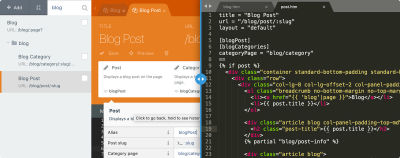
Core Vs. Plugin Functionality
WordPress attempts to deliver a minimal core functionality which is enhanced through plugins. WordPress relies on the “80⁄20 rule” to decide if to include some functionality in its core experience or not. If it benefits 80% of the users it goes in, otherwise, it belongs to plugin-land. When adding plugins to a site, they can lead to bloat if too many plugins are installed. Plugins may also not work well with one another, or execute similar code or load similar assets, resulting in suboptimal performance. Hence, whereas launching a WordPress site is relatively easy, a bigger challenge is its general maintenance and being able to preserve an optimal and performant state when adding new features.
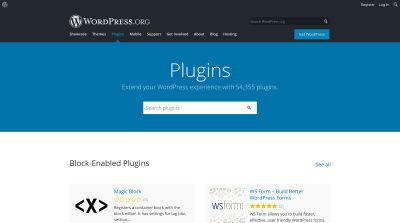
Likewise, October CMS also attempts to deliver a minimal core functionality, but on steroids: the only guaranteed functionality is the creation and publication of pages, and for everything else we will need to install one plugin or another, which is expressed as:
“Everything you need, and nothing you don't.”
The objective is clear: most simple sites are only composed of pages, with possibly no blog posts, users or login area. So why should the application load resources for these when they are not needed? As a consequence, functionalities for blogging, user management, translation and several others are released through the plugin directory.
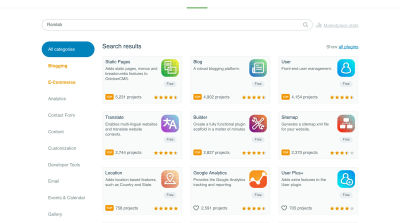
October CMS also includes certain features in its core which (even though they are not always needed) can enhance the application significantly. For instance, it provides out-of-the-box support to upload media files to Amazon S3 and accesses them through the Rackspace CDN. It also includes a Media Manager which is mostly used through plugins, e.g. for adding images into a blog post. (Pages can also use the Media Manager to embed media files, however, the CMS also ships with an Assets section to upload media files for these which seems more suitable.)
I believe that October’s opinionatedness can perfectly enable us to produce an application that is as lean as possible — mostly concerning simple sites. However, it can also backfire and encourage bloat, because the line of what is needed and what is not is an arbitrary one, and it’s difficult to be set in advance by the CMS. This difficulty can be appreciated when considering the concept of a “user”: In WordPress, website users and website admins belong to the same user entity (and through roles and privileges we can make a user become an admin). In October CMS, these two are implemented separately, shipping in core the implementation for the website administrator which can log in to the backend area and modify the settings, and through a plugin the implementation of the website user. These two types of users have a different login process and a different database table for storing their data, thus arguably breaching the DRY (Don’t Repeat Yourself) principle.
This problem arises not only concerning the behavior of an entity but also what data fields it must contain. For instance, should the website user data fields be predefined? Is a telephone field required? What about an Instagram URL field, considering that Instagram got kind of cool only recently? But then, when building a professional website shouldn’t we use a LinkedIn URL field instead? These decisions clearly depend on the application and can’t be decided by either CMS or plugin.
The October CMS plugin called User implements users but without any user field, on top of which plugin User Plus adds several arbitrary user fields, which are possibly not enough, so plugin User Plus+ adds yet other user fields. When, where and how do we stop this process?
Another problem is when there is no room to add new capabilities to an entity, which leads to the creation of another, extremely similar entity, just to support those required capabilities. For instance, October CMS ships with pages, and allows to create “static pages” through a plugin. Their nature is the same: both pages and static pages are saved as static files. The only difference between them (as far as I can tell) is that static pages are edited with a visual editor instead of the HTML editor, and can be added to menus. In my opinion, only structural differences, such as having one entity saved as a static file and the other one stored in the database, could justify creating a second entity for a page (there is a pull request to do this), but for simple features, as is the case currently, it constitutes development bloat.
In summary, a well implemented October CMS application can be very lean and efficient (e.g. by removing the database when not needed), but on the contrary it can also become unnecessarily bloated, forcing developers to implement several solutions for similar entities, and which can be very confusing to use (“Should I use a page or a static page?”). Because neither WordPress or October CMS has found a perfect solution for removing bloat, we must design either application architecture with care to avoid down-the-road pain.
Content Creation
Gutenberg makes two important contributions to WordPress: It uses components as the unit for building sites (which offers several advantages over coding blobs of HTML), and it introduces an entity called a “block” which, once Gutenberg Phase 2 is completed (presumably in 2019), will provide a unified way to incorporate content into the site, thus enabling a simpler user experience as opposed to the more chaotic process of adding content through shortcodes, TinyMCE buttons, menus, widgets, and others.
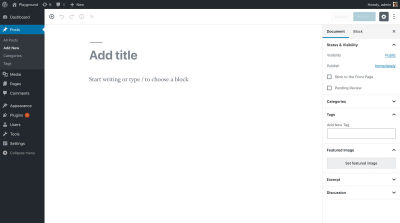
Because Gutenberg blocks can produce and save static HTML as part of the blog post, then installing many Gutenberg blocks doesn’t necessarily translate into bloat on the website on the user side, but can be kept restricted to the admin side. Hence, Gutenberg can arguably be considered a good approach to produce websites in a modular way, with a simple yet powerful user experience for creating content. Possibly the biggest drawback is the (unavoidable, but not easily so) requirement to learn React, whose learning curve is rather steep.
If React components are the basic unit for creating content in WordPress, October CMS is based on the premise that knowing good old HTML is enough for building sites. Indeed, when creating a page, we are simply presented an HTML (Markup) editor:
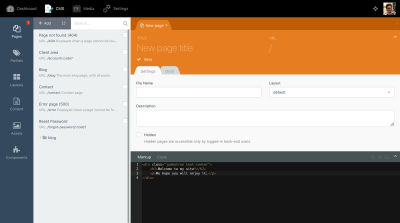
If the page were solely static HTML, then there would be no need for a CMS. Instead, October CMS pages are written using Twig templates which are compiled to plain optimized PHP code. They can select a layout to include the scaffolding of the page (i.e. repetitive elements, such as the header, footer, and so on), can implement placeholders, which are defined on the layout to allow the page to customize content, and can include partials, which are reusable chunks of code. In addition, pages can include content blocks, which are either text, HTML or Markdown files that can be edited on their own and can attach components which are functionalities implemented through plugins. And finally, for whenever HTML is not enough and we need to produce dynamic code, we can add PHP functions.
The editor is all about HTML. There is no TinyMCE textarea for adding content in a visual manner — at least not through the default experience (this functionality belongs to plugin-land). Hence, having knowledge of HTML could be considered a must for using October CMS. In addition, the several different inputs for creating content (pages, layouts, placeholders, partials, content blocks, components, and PHP functions) may be very effective, however, it is certainly not as simple as through the unified block interface from WordPress. It can even get more complex since other elements can also be added (such as static pages and menus, and snippets), and some of them, such as pages and static pages, seemingly provide the same functionality, making it confusing to decide when to use one or the other.
As a result, I dare say that while pretty much anyone can use a WordPress site from the admin side, October CMS is more developer-friendly than non-technical user-friendly, so programmers may find it a joy to use, but certain other roles (marketers, sales people, and the like) may find it non-intuitive.
Media Manager
Both WordPress and October CMS are shipped with a Media Manager which allows adding media files to the site effortlessly, supporting the addition of multiple files simultaneously through a drag-and-drop interface and displaying the images within the content area. They look and behave similarly; the only notable differences I found are that WordPress’ Media Manager allows to embed image galleries, and October’s Media Manager allows to manually create a folder structure where to place the uploaded files.
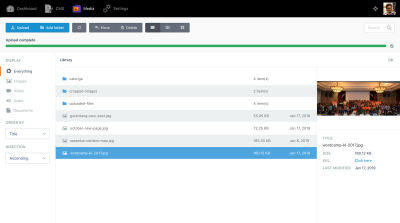
Since the introduction of Gutenberg, though, WordPress’ media capabilities have been enhanced greatly, enabling to embed videos, pictures and photo galleries in place as compared to within a TinyMCE textarea (which only provides a non-accurate version of how it will look like in the site), and unlocking powerful, yet easy-to-use features as shown in this video.
Internationalization
WordPress core uses gettext to enable the translation of themes and plugins. Starting from a .pot file containing all strings to translate, we need to create a .po file containing their translation to the corresponding language/locale, and this file is then compiled to a binary .mo file suitable for fast translation extraction. Tools to perform these tasks include GlotPress (online) and Poedit (downloadable application). Conveniently, this mechanism also works for client-side localization for Gutenberg.
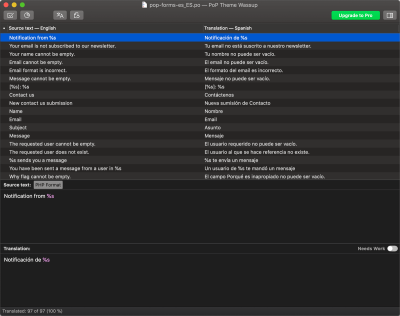
WordPress currently doesn’t ship any solution in core to translate content, and will not do so until Phase 4 of Gutenberg (targeted for year 2020+). Until then, this functionality is provided by plugins which offer different strategies for storing and managing the translated content. For example, while plugins such as Polylang and WPML store each translation on its own row from a custom database table (which is clean since it doesn’t mix content together, but slower since it requires an additional INNER JOIN of two tables when querying the database), plugin qTranslate X stores all translations on the same field from the original database table (faster for querying the data, but content mixed all together can produce wreckage on the site if disabling the plugin). Hence, we can shop around and decide the most suitable strategy for our needs.
October CMS doesn’t ship the multilingual functionality through its core, but as a plugin created by the October CMS team that guarantees a faultless integration into the system. From a functional point of view, this plugin delivers what it promises. From a development point of view, it is not quite ideal how this plugin actually works. In WordPress, a page is simply a post with post type “page” and there is a single translation mechanism for them, but in October CMS, there are entities “page”, “static page” and “blog post” and, even though quite similar, they require three different implementations for their translations! Then, the content from a “page” can include message codes (e.g. codes called nav.content, header.title, and so on), each of which contains its translations for all locales as a serialized JSON object in database table rainlab_translate_messages. The content from a “static page” is created into a new static file per locale, however, all translated URLs for all locales are stored not in their corresponding file but instead on the default language’s file. The content for the “blog post” is stored as a serialized JSON object with one row per locale in database table rainlab_translate_attributes and the translated URL is stored with one row per locale in database table rainlab_translate_indexes. I don’t know if this complexity is due to how the plugin was implemented or whether it is due to October CMS’ architecture. Whichever the case, this is another instance of undesired bloat on the development side.
Plugin Management
Both WordPress and October CMS offer a sophisticated plugin manager which allows to search for plugins, install new plugins, and update currently-installed plugins to their latest version — all from within the backend.
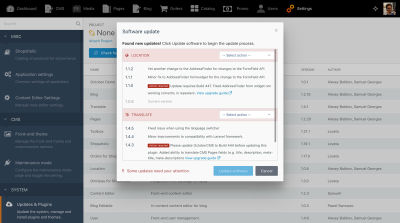
Dependency Management
October CMS uses Composer as the package manager of choice, enabling plugins to download and install their dependencies when being installed, thus delivering a painless experience.
WordPress, on the opposite side, hasn’t officially adopted Composer (or any PHP dependency manager) because the community can’t agree if WordPress is a site or a site dependency. Hence, if they require Composer for their projects, developers must add it on their own. With the switch to Gutenberg, npm has become the preferred JavaScript dependency manager, with a popular developer toolkit depending on it, and the client-side libraries being steadily released as autonomous packages in the npm registry.
Interaction With The Database
WordPress provides functions to retrieve database data (such as get_posts) and store it (such as wp_insert_post and wp_update_post). When retrieving data, we can pass parameters to filter, limit and order the results, in order to indicate if the result must be passed as an instance of a class or as an array of properties and others. When the function doesn’t fully satisfy our requirements (e.g. when we need to do an INNER JOIN with a custom table) then we can query the database directly through global variable $wpdb. When creating a plugin with a custom post type, the code will most likely be executing custom SQL queries to retrieve and/or save data into custom tables. In summary, WordPress attempts to provide access to the database through generic functions in the first stage, and through low-level access to the database in the second stage.
October CMS employs a different approach: Instead of connecting to the database straight away, the application can use Laravel’s Eloquent ORM to access and manipulate database data through instances of classes called Models, making the interaction with the database also be based on Object-Oriented Programming. It is high-level access; just by following the rules on how to create tables and set-up relationships among entities, a plugin can retrieve and/or save data without writing a line of SQL. For instance, the code below retrieves an object from the database through model Flight, modifies a property, and stores it again:
$flight = Flight::find(1);
$flight->name = 'Darwin to Adelaide';
$flight->save();
Upgrading The Data Model
Another reason for WordPress’ success (in addition to not breaking backward compatibility) has been its database architecture, which was engineered to enable applications to grow over time. This objective is accomplished through “meta” properties, i.e. properties that can be loosely added to a database object at any moment. These properties are not stored in a column from the corresponding entity table (either wp_posts, wp_users, wp_comments or wp_terms), but instead as a row in the corresponding “meta” table (wp_postmeta, wp_usermeta, wp_commentmeta or wp_termmeta) and retrieved doing an INNER JOIN. Hence, even though retrieving these meta values is slower, they provide unlimited flexibility, and the application’s data model rarely needs to be re-architected from scratch in order to implement some new functionality.
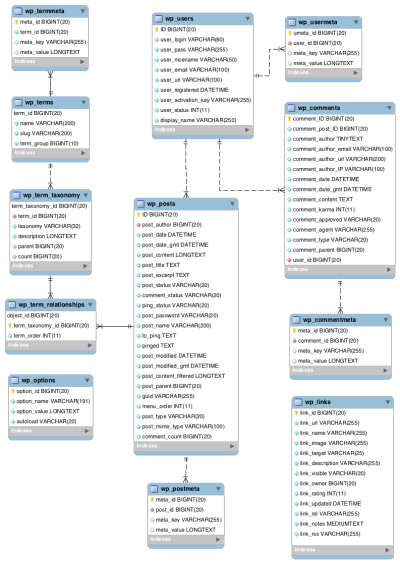
October CMS doesn’t use meta properties but instead can store several arbitrary values, which are not directly mapped as columns in the database tables, as a serialized JSON object. Otherwise, when an object needs some new property, we need to add a new column on the corresponding table (which is the reason behind plugins User Plus and User Plus+, mentioned earlier on). To update the application’s database schema, October CMS relies on Laravel’s Migrations, which are sets of instructions to execute against the schema (such as add or drop a column, rename an index, etc) and which are executed when upgrading the software (e.g. when installing a plugin’s new version).
Headless Capabilities
Both WordPress and October CMS can be used as headless, i.e. treating the CMS as a content management system that makes content accessible through APIs, which allows to render the website on the client-side and can power other applications (such as mobile apps). Indeed, WordPress is steadily heading towards headless, since the Gutenberg content editor itself treats WordPress as a headless CMS (and, as a consequence, Gutenberg can also work with any other CMS too, as Drupal Gutenberg demonstrates).
A headless system needs to implement some API to return the data, such as REST and GraphQL. WordPress supports REST through WP REST API (merged in core), exposing endpoints under some predefined route /wp-json/wp/v2/...; October CMS supports REST through plugins RESTful and API Generator, which allow to create custom endpoints and, as a consequence, support versioning as part of the endpoint URL and can offer a better security against bots. Concerning GraphQL, WordPress supports it through WPGraphQL, while October CMS currently has no implementations for it.
Quite importantly, a headless system needs to offer powerful content management capabilities. As mentioned earlier on, WordPress has a very solid database architecture, offering a plethora of data entities (users, posts and custom posts, pages, categories, tags and custom taxonomies, comments) over which the application can be reasonably well modelled, meta properties to extend these data entities (enabling the application to upgrade its data model accordingly and without major changes), and with plugin Advanced Custom Fields filling the gap to construct relationships among the data entities. In addition, plugin VersionPress allows to version control the database content using Git. Hence, WordPress is undoubtedly a good fit for managing content, as demonstrated in several projects in the wild.
On its part, and as mentioned earlier on, October CMS can omit the database and behave as a flat-file system, or it can have a database and behave as a hybrid, storing the content from pages as static files and blog posts (and others) on the database. As a consequence, content is not centralized, and its management involves a different approach. For instance, while we can use Git to version control pages, there is no support to version control the database per se; the solution to this is to populate data into the database through Seeders which, being code, can be put under version control and executed upon deployment. In addition, October CMS doesn’t offer a baked-in database model featuring predefined data entities that can support the needs of most applications. Hence, more likely than not the application will need custom development to implement its data model, which means more work, but also means that it can be more efficient (e.g. accessing a property from a column is faster than from a row in another table through an INNER JOIN, which is the case with WordPress’ meta properties).
CLI Support
Both WordPress and October CMS can be interacted with from the console through a Command Line Interface (CLI): WordPress through WP-CLI and October CMS through Laravel’s Artisan. In addition to Laravel’s commands, October CMS implements several custom commands for updating the system, migrating the database, and others. These tools make it very convenient to access the site from outside a browser, for instance for testing purposes.
Managed Hosting
It is not a problem finding a managed hosting provider for a WordPress site: given WordPress’ market share, there are dozens (if not hundreds) of providers out there vying with each other for the business, constituting a very dynamic market. The only problem is finding the most suitable provider for our specific sites based on all of their offerings, which can vary based on price, quality, type (shared or dedicated services), bandwidth and storage size, customer support, location, frequency of renewal of equipment, and other variables which we can navigate mainly through reviews comparing them (such as this one, this one or this one).
Even though nothing near as many as WordPress, October CMS still enjoys the offering from several hosting providers, which allows for some consideration and selection. Many of them are listed as October Partners, and several others are found DuckDuckGoing, but since I haven’t found any independent review of them or article comparing them, the task of finding out the most suitable one will take some effort.
Marketplace, Ecosystem And Cost
WordPress’ commercial ecosystem is estimated to be USD $10 billion/year, evidencing how many people and companies have managed to make a living by offering WordPress products and services, such as the creation of sites, hosting, theme and plugin development, support, security, and others. Indeed, its size is so big it is even bloated, meaning that it is very common to find different plugins solving the same problem, plugins that underdeliver, underperform or have not been updated for years, and themes which seem to look-alike each other. However, when creating a new site, the size and variety of the ecosystem also means that we will most likely find at least one plugin implementing each of the required functionalities, enabling us to save money by not having to develop the functionality ourselves, and the availability of customizable themes enables to produce a reasonably distinctive-looking site with minimal effort. As a consequence, we can easily create and launch a WordPress site for less than USD $100, making WordPress a sensible option for projects of any budget.
Being relatively new (only five years so far), OctoberCMS certainly doesn’t enjoy anything near WordPress’ marketplace and ecosystem sizes, however, it has been growing steadily so its size is bound to become bigger. Currently, its marketplace boasts 600+ plugins, and only a handful of themes. Concerning plugins, the October CMS team is requesting the community to put their effort into the creation of original plugins, delivering functionality not yet provided by any other plugin.
Hence, even though 600+ plugins doesn’t sound like much, at least these translate into 600+ different functionalities. This way, even though it is not possible to choose among several vendors, at least we can expect to have those basic website features (such as blogging, comments, forum, integration with social media, e-commerce, and others) to be covered. Also, since October’s founders are personally reviewing all submitted plugins and judging them according to quality guidelines, we can expect these plugins to perform as expected. As another plus, October plugins can incorporate elements from Laravel packages (even though not all of them are compatible with October, at least not without some hacks). Concerning themes, the low number of offerings implies we will most likely need to develop our own theme by hiring a developer for the task. In fact, I dare say that the theme in October CMS will most likely be a custom development, since themes and plugins are not thoroughly decoupled (as explained earlier), with the consequence that a market for easily-swappable themes is more difficult to arise. (This is a temporary problem though: once this pull request is resolved, pages will be able to be stored in the database, and swapping themes should not disrupt functionality.)
In my opinion, because of the smaller offerings of themes and plugins, creating a simple site with OctoberCMS will be more expensive than creating a simple WordPress site. For complex sites, however, October’s better architecture (Object-Oriented Programming and Model-View-Controller paradigms) makes the software more maintainable and, as a consequence, potentially cheaper.
Community
Being a part of and having access, WordPress’ community represents one of the most compelling reasons for using WordPress. This is not simply as a matter of size (powering nearly one third of all websites in the world, there are so many stakeholders involved with WordPress, and its community is representatively big) but also as a matter of diversity. The WordPress community involves people from many different professions (developers, marketers, designers, bloggers, sales people, and so on), from all continents and countries, speaking countless languages, from different social, educational and economic backgrounds, with or without disabilities, from corporate, not-for-profit and governmental organizations, and others. Hence, it is quite likely that, for whatever problem we encounter, somebody will be able to help on any of the support forums. And contributing to WordPress is pretty straightforward too: The Make WordPress group congregates stakeholders interested in supporting different projects (accessibility, design, internationalization, and many others) and organizes how and how regularly they communicate — mostly through some dedicated channel on its Slack workspace.
Furthermore, the WordPress community is real and tangible: it doesn’t exist just online, but it gathers offline in WordCamps and meetups all over the world; in 2018, there were a total of 145 WordCamps in 48 countries with over 45,000 tickets sold, and a total of 5,400 meetup events from 687 meetup groups. Hence, it is likely that there is a local chapter nearby which anyone can join to ask for help, learn how to use the platform, keep learning on a regular basis, and teach others as well. In this sense, WordPress is not just a CMS but, more importantly, it’s also people, and considering to leave WordPress should never be done only on its technical merits but on the power of its community, too.
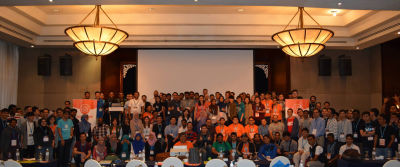
October CMS’ community is nothing near in size or diversity as WordPress’, even though it has been growing steadily following the increasing popularity of the software. October provides a support forum to ask for help, however, it is not very active. A Slack workspace exists which is pretty active and where, quite importantly, October’s founders participate regularly, helping make sure that all enquiries are properly addressed. This channel is a great source for learning low-level tips and tricks about the software, however, it is geared towards developers mainly: There are no channels concerning accessibility, design, internationalization, and other topics as in the WordPress community, at least not yet. Currently, there are no conferences concerning October CMS, but there is Laracon, the conference for the Laravel community.
Maintainers And Governance
Can we trust that the software will be maintained in the long term, so that if we decide to start a project today, we will not need to migrate to some other platform down the road? How many people are taking care of developing the software? And who is deciding in what direction the software moves towards?
Powering one-third of all sites in the world, WordPress is not short of stakeholders contributing to the software; hence we need not fear that the software will fall into decay. However, WordPress is going through internal deliberations concerning its governance model, with many members of the community expressing that decisions concerning WordPress’s direction are being taken unilaterally by Automattic, the company running WordPress.com. Center stage of this perception was the decision to launch Gutenberg, which many members disagreed with, and which suffered a lack of proper communication by the project leads during its development and release. As a consequence, many community members are questioning the role of “benign dictator”, which has been historically granted to WordPress’ founder and Automattic’s CEO Matt Mullenweg, and researching different governance models to find a more suitable one for the future of WordPress. It is yet to be seen if this quest produces any result, or if the status quo perseveres.
Decisions concerning October CMS’ direction are mainly taken by founders Alexey Bobkov and Samuel Georges and developer and community manager Luke Towers, which keep the project going strong. October CMS doesn’t have the luxury of having a governance problem yet: Its current concern is how to make the project sustainable by generating income for the core software’s maintainers.
Documentation
WordPress documentation in its own site is not extremely comprehensive, but it does the job reasonably well. However, when taking all of the documentation about WordPress into account from all sources, such as general sites (Smashing Magazine, CSS tricks, and many others), specialized sites (WPShout, WPBeginner, and many others), personal blogs, online courses, and so on, there is practically no aspect of dealing with WordPress that hasn’t already been covered.
October CMS doesn’t enjoy anything near the many third-party courses, tutorials or blog posts about it as much as WordPress does, however, the documentation on its site is reasonably comprehensive and certainly enough to start coding. October founders also regularly add new documentation through tutorials. One aspect that I personally enjoyed is the duplication of Laravel’s documentation into October’s documentation for everything of relevance, so the reader must not fill the gaps by him/herself and having to guess what is October’s domain and what is Laravel’s. However, this is not 100% perfect. October’s documentation uses terms originating from Laravel, such as middleware, service containers, facades and contracts, without adequately explaining what these are. Then, reading Laravel’s documentation in advance can be helpful (luckily, Laravel’s documentation is decidedly comprehensive, and Laravel’s screencasts, Laracasts, are another great source of learning, not just concerning Laravel but web development in general).
Conclusion
I set out to discover what features may be enticing for developers looking for alternatives to WordPress by comparing WordPress to a similar CMS, which I defined as being free and open source, based in PHP and producing dynamic content, and enjoying the support from some community. From the CMSs fulfilling these conditions, I chose October CMS for the comparison because of the knowledge I got about it, and because I appreciated its clean and modular coding approach as provided by Laravel, which could offer a fresh and modern perspective for building sites.
This article did not intend to pick a winner, but simply analyze when it makes sense to choose one or the other CMS, highlighting their strengths and weaknesses. There is no “best” CMS: only the most suitable CMS for a specific situation. Furthermore, anyone looking for a CMS to use on a particular project with a specific team and given a certain budget, should do some research and compare all the offerings out there to find out which one is most suitable for the particular context. It’s important not to limit to a few CMSs as I’ve done here in this article, but instead give a chance to all of them.
On a personal note, as a developer, what I found in October CMS is really appealing to me, mostly its ability to build modular applications as provided through Laravel. I would certainly consider this CMS for a new website. However, in the process of writing this article I also “rediscovered” WordPress. Being so popular, WordPress receives more than its fair share of criticisms, mostly concerning its old codebase and, since recently, the introduction of Gutenberg; however, WordPress also has certain excellent features (such as its super-scalable database model) which are seldom praised but should be taken into account too. And most importantly, WordPress should not be considered on its technical aspects alone: in particular, the size of its community and ecosystem places it a level or two above its alternatives. In a nutshell, some projects may benefit from sticking to WordPress, while others may better rely on October CMS or another platform.
As a final note, I would like to remark that exploring how another CMS works is a very rewarding activity on its own, independent of the decision reached concerning whether to use that particular CMS or not. In my case, I had been working for years on WordPress alone, and delving into October CMS was very refreshing since it taught me many things (such as the existence of PHP Standards Recommendations) which I had not been exposed to through WordPress. I may now decide to switch CMSs, or stick to WordPress knowing how to produce better code.
Further Reading
- Caching Smartly In The Age Of Gutenberg
- Improving WordPress Code With Modern PHP
- Lessons Learned While Developing WordPress Plugins
- How To Use Heatmaps To Track Clicks On Your WordPress Website
- Be Watchful: PHP And WordPress Functions That Can Make Your Site Insecure








